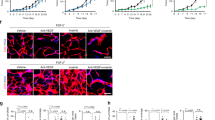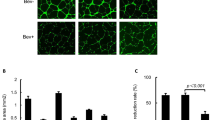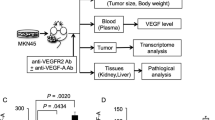Abstract
We determined the impact of HER2 signaling on two proangiogenic factors, vascular endothelial growth factor (VEGF) and interleukin-8 (IL-8), and on an antiangiogenic factor, thrombospondin-1 (TSP-1). Re-expression of HER2 in MCF-7 and T-47D breast cancer cells that endogenously express low levels of HER2 resulted in elevated expression of VEGF and IL-8 and decreased expression of TSP-1. Inhibition of HER2 with a humanized anti-HER2 antibody (trastuzumab, or Herceptin®) or a retrovirus-mediated small interfering RNA against HER2 (siHER2) decreased VEGF and IL-8 expression, but increased TSP-1 expression in BT474 breast cancer cells that express high levels of HER2. These in vitro results were further evaluated by treatment of BT474 xenografts in immunosuppressed mice with trastuzumab. Trastuzumab inhibited growth of BT474 xenografts and decreased microvascular density associated with downregulation of VEGF and IL-8 and with upregulation of TSP-1 expression. Inhibiting the PI3K-AKT pathway decreased VEGF and IL-8 expression. AKT1 overexpession increased VEGF and IL-8 expression, but did not increase TSP-1 expression. A p38 kinase inhibitor, SB203580, instead blocked TSP-1 expression and a p38 activator, MKK6, increased TSP-1 expression. Trastuzumab stimulated sustained p38 activation and SB203580 attenuated the TSP-1 upregulation induced by trastuzumab. HER2 signaling therefore influences the equilibrium between pro- and antiangiogenic factors via distinct signaling pathways. Trastuzumab inhibits angiogenesis and tumor growth, at least in part, through activation of the HER2-p38-TSP-1 pathway and inhibition of the HER2-PI3K-AKT-VEGF/IL-8 pathway.
This is a preview of subscription content, access via your institution
Access options
Subscribe to this journal
Receive 50 print issues and online access
$259.00 per year
only $5.18 per issue
Buy this article
- Purchase on Springer Link
- Instant access to full article PDF
Prices may be subject to local taxes which are calculated during checkout






Similar content being viewed by others
References
Bagheri-Yarmand R, Vadlamudi RK, Wang RA, Mendelsohn J, Kumar R . (2000). J Biol Chem 275: 39451–39457.
Bar-Eli M . (1999). Pathobiology 67: 12–18.
Baselga J, Gianni L, Geyer C, Perez EA, Riva A, Jackisch C . (2004). Semin Oncol 31 (5 Suppl 10): 51–57.
Baselga J, Norton L, Albanell J, Kim YM, Mendelsohn J . (1998). Cancer Res 58: 2825–2831.
Benoy IH, Salgado R, Van Dam P, Geboers K, Van Marck E, Scharpe S et al. (2004). Clin Cancer Res 10: 7157–7162.
Bulavin DV, Fornace Jr AJ . (2004). Adv Cancer Res 92: 95–118.
Chelouche-Lev D, Miller CP, Tellez C, Ruiz M, Bar-Eli M, Price JE . (2004). Eur J Cancer 40: 2509–2518.
Chen JJ, Yao PL, Yuan A, Hong TM, Shun CT, Kuo ML et al. (2003). Clin Cancer Res 9: 729–737.
Cobleigh MA, Vogel CL, Tripathy D, Robert NJ, Scholl S, Fehrenbacher L et al. (1999). J Clin Oncol 17: 2639–2648.
Crown J, Pegram M . (2003). Breast Cancer Res Treat 79 (Suppl 1): S11–S18.
Daly JM, Olayioye MA, Wong AM, Neve R, Lane HA, Maurer FG et al. (1999). Oncogene 18: 3440–3451.
Dawson DW, Pearce SF, Zhong R, Silverstein RL, Frazier WA, Bouck NP . (1997). J Cell Biol 138: 707–717.
De Larco JE, Wuertz BR, Rosner KA, Erickson SA, Gamache DE, Manivel JC et al. (2001). Am J Pathol 158: 639–646.
Dimmeler S, Zeiher AM . (2000). Circ Res 86: 4–5.
Ferrara N . (2002). Semin Oncol 29: 10–14.
Finn RS, Slamon DJ . (2003). Cancer Chemother Biol Response Modif 21: 223–233.
Freund A, Chauveau C, Brouillet JP, Lucas A, Lacroix M, Licznar A et al. (2003). Oncogene 22: 256–265.
Green AR, Green VL, White MC, Speirs V . (1997). Int J Cancer 72: 937–941.
Hanahan D, Weinberg RA . (2000). Cell 100: 57–70.
Harmey JH, Bouchier-Hayes D . (2002). Bioessays 24: 280–283.
Holash J, Davis S, Papadopoulos N, Croll SD, Ho L, Russell M et al. (2002). Proc Natl Acad Sci USA 99: 11393–11398.
Holbro T, Hynes NE . (2004). Annu Rev Pharmacol Toxicol 44: 195–217.
Izumi Y, Xu L, di Tomaso E, Fukumura D, Jain RK . (2002). Nature 416: 279–280.
Jiang BH, Zheng JZ, Aoki M, Vogt PK . (2000). Proc Natl Acad Sci USA 97: 1749–1753.
Jimenez B, Volpert OV, Crawford SE, Febbraio M, Silverstein RL, Bouck N . (2000). Nat Med 6: 41–48.
Klos KS, Zhou X, Lee S, Zhang L, Yang W, Nagata Y et al. (2003). Cancer 98: 1377–1385.
Kumar R, Yarmand-Bagheri R . (2001). Semin Oncol 28 (5 Suppl 16): 27–32.
Le XF, Claret FX, Lammayot A, Tian L, Deshpande D, LaPushin R et al. (2003). J Biol Chem 278: 23441–23450.
Le XF, Lammayot A, Gold D, Lu Y, Mao W, Chang T et al. (2005a). J Biol Chem 280: 2092–2104.
Le XF, Mu Z, Vallian S, Hung MC, Chang KS . (1998). Oncogene 16: 1839–1849.
Le XF, Pruefer F, Bast Jr RC . (2005b). Cell Cycle 4: 87–95.
Le XF, Vadlamudi R, McWatters A, Bae DS, Mills GB, Kumar R et al. (2000). Cancer Res 60: 3522–3531.
Loureiro RM, Maharaj AS, Dankort D, Muller WJ, D'Amore PA . (2005). Biochem Biophys Res Commun 326: 455–465.
Marmor MD, Skaria KB, Yarden Y . (2004). Int J Radiat Oncol Biol Phys 58: 903–913.
Miller KD, Chap LI, Holmes FA, Cobleigh MA, Marcom PK, Fehrenbacher L et al. (2005). J Clin Oncol 23: 792–799.
Nahta R, Esteva FJ . (2003). Clin Cancer Res 9: 5078–5084.
Naito T, Masaki T, Nikolic-Paterson DJ, Tanji C, Yorioka N, Kohno N . (2004). Am J Physiol Renal Physiol 286: F278–F287.
Pegram MD, Reese DM . (2002). Semin Oncol 29 (3 Suppl 11): 29–37.
Petit AM, Rak J, Hung MC, Rockwell P, Goldstein N, Fendly B et al. (1997). Am J Pathol 151: 1523–1530.
Price DJ, Miralem T, Jiang S, Steinberg R, Avraham H . (2001). Cell Growth Differ 12: 129–135.
Ribatti D, Alessandri G, Vacca A, Iurlaro M, Ponzoni M . (1998). Int J Cancer 77: 449–454.
Rodriguez-Manzaneque JC, Lane TF, Ortega MA, Hynes RO, Lawler J, Iruela-Arispe ML . (2001). Proc Natl Acad Sci USA 98: 12485–12490.
Rofstad EK, Halsor EF . (2002). Br J Cancer 86: 301–308.
Sargiannidou I, Zhou J, Tuszynski GP . (2001). Exp Biol Med 226: 726–733.
Shahied LS, Tang Y, Alpaugh RK, Somer R, Greenspon D, Weiner LM . (2004). J Biol Chem 279: 53907–53914.
Sparmann A, Bar-Sagi D . (2004). Cancer Cell 6: 447–458.
Spiridon CI, Guinn S, Vitetta ES . (2004). Clin Cancer Res 10: 3542–3551.
Stein S, DeMichele A, Domchek S, Fox K . (2004). Clin Breast Cancer 4 (Suppl 3): S117–S120.
Takekawa M, Tatebayashi K, Itoh F, Adachi M, Imai K, Saito H . (2002). EMBO J 21: 6473–6482.
Watnick RS, Cheng YN, Rangarajan A, Ince TA, Weinberg RA . (2003). Cancer Cell 3: 219–231.
Xiong S, Grijalva R, Zhang L, Nguyen NT, Pisters PW, Pollock RE et al. (2001). Cancer Res 61: 1727–1732.
Yang G, Cai KQ, Thompson-Lanza JA, Bast Jr RC, Liu J . (2004). J Biol Chem 279: 4339–4345.
Yen L, Benlimame N, Nie ZR, Xiao D, Wang T, Al Moustafa AE et al. (2002). Mol Biol Cell 13: 4029–4044.
Yu D, Hung MC . (2000). Oncogene 19: 6115–6121.
Zhang H, Richter M, Greene MI . (2003). Cancer Biol Ther 2 (4 Suppl 1): S122–S126.
Acknowledgements
We sincerely thank Dr Maureen Goode for critical review of this manuscript; Dr José Baselga (Vall d'Hebron University Hospital, Barcelona, Spain) for providing the BT474 cells used in the xenografts experiments. We are also grateful to Genentech Corp (South San Francisco, CA) for providing trastuzumab (Herceptin®) and 4D5 antibodies. Dr Han Jiahuai at Scripps Research Institute, La Jolla, CA, generously provided the MKK6 vector. The Media Preparation Core Facility and Animal Core Facility were supported in part by the Cancer Center Support Grant CA No. 16672 from NCI. This work was supported in part by grant CA39930 from the National Cancer Institute (to RCB) and by grant 80094241 from Goodwin Foundation (to XFL).
Author information
Authors and Affiliations
Corresponding authors
Rights and permissions
About this article
Cite this article
Wen, XF., Yang, G., Mao, W. et al. HER2 signaling modulates the equilibrium between pro- and antiangiogenic factors via distinct pathways: implications for HER2-targeted antibody therapy. Oncogene 25, 6986–6996 (2006). https://doi.org/10.1038/sj.onc.1209685
Received:
Revised:
Accepted:
Published:
Issue Date:
DOI: https://doi.org/10.1038/sj.onc.1209685
Keywords
This article is cited by
-
Plasma THBS1 as a predictive biomarker for poor prognosis and brain metastasis in patients with HER2-enriched breast cancer
International Journal of Clinical Oncology (2024)
-
Breast ductal Carcinoma in situ associated with microinvasion induces immunological response and predicts ipsilateral invasive recurrence
Virchows Archiv (2021)
-
The effects of trastuzumab on HER2-mediated cell signaling in CHO cells expressing human HER2
BMC Cancer (2018)
-
Differential expression of VEGFR2 protein in HER2 positive primary human breast cancer: potential relevance to anti-angiogenic therapies
Cancer Cell International (2017)
-
Interleukin 8 in progression of hormone-dependent early breast cancer
Journal of Biosciences (2017)



